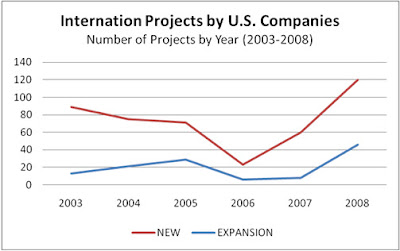U. S. companies are expanding to overseas markets at a faster rate in 2008 and 2009 than ever before, despite the recession. Whittaker Associates analyzed projects done by U. S. companies in foreign countries and identified 740 such projects since January 2003. These projects were spread across 68 different countries and totaled almost $40 billion. Mexico, China, India, Ireland and Canada have gotten the greatest number of projects, accounting for almost half of all the projects done by U. S. companies around the world.
CAUTION: The data used in this analysis was collected by Conway Data. Conway Data has kept a “scoreboard” of significant new and expanded project announcements in the U. S. A. and around the world. In recent years, this coverage has been extended to areas around the world, although the North American coverage remains more extensive. Conway only counts projects that have an investment greater than $1 million, a floor area more than 20,000 sq. ft., or an employment increase of more than 50. Therefore, this dataset does not account for all the investments made by U. S. companies, but it gives us the ability to analyze the trends and nature of business investments around the world.
 Figure 1 to the right shows the trend of these projects between 2003 and 2008. To our surprise, international project activity by U. S. companies has been on the rise despite the economic slowdown. In 2008, we saw a record 120 new projects and 46 expansion projects announced by U. S.-based companies in overseas markets. In the first three quarters in 2009, we have already seen 143 new project announcements, totaling a record $6.2 billion in overseas investments.
Figure 1 to the right shows the trend of these projects between 2003 and 2008. To our surprise, international project activity by U. S. companies has been on the rise despite the economic slowdown. In 2008, we saw a record 120 new projects and 46 expansion projects announced by U. S.-based companies in overseas markets. In the first three quarters in 2009, we have already seen 143 new project announcements, totaling a record $6.2 billion in overseas investments.
International expansion may have spiked higher in the last two years because many companies are using it as an antidote to shrinking domestic markets. Markets like China and India, with their burgeoning middle classes, are great places to be for U. S. companies.
Unlike many companies around the world, many U. S. companies start out to serve demands in the domestic markets. As a result, U. S. companies considering international expansion are already at an advantage because they already have a well-marketed product or service.
Here are some steps that many site-selection experts recommend for a business looking at international expansion:
1. Research, Research, Research: This step involves a look at your current or past international clients and short-listing countries or regions where there seems to be a demand for your products or services. You will also need to consider whether your business is ready for the move. Is organization fully prepared? Do you have any budgetary or human capital constraints? Do you or your partners have any international experience? It is important to do some secondary research on your target markets, but nothing can replace direct personal contact with local industry experts, existing customers or trade commissioners.
2. Select a Market: Too often businesses are overwhelmed with the choices they face and the work that needs to be done during an international expansion. It is always best to select countries or regions where your product/service will have the best prospect and demand. Along with establishing whether there is demand for your product in that foreign market, you will have to consider the legal environment, political conditions and infrastructure if all of your needs will be met by the country/region you select.
3. Know your Target: It may be foolish to assume that your product will meet the needs of an international consumer the way it met the needs of your domestic consumer. Various international audiences have different needs, unique preferences and diverse ways/nuances of conducting business. Only with a thorough understanding of the target market can a business make wise and sustainable economic decisions about product adaptation and, ultimately, be very certain that success is financially obtainable.
4. The Five P’s of International Marketing: there are five more P’s to consider with an international strategic marketing plan:
• Payment – Exchange rates, terms, customs valuations, transfer pricing, taxes
• Practices – Unique cultural, social and business styles
• Paperwork – Permits, licenses and other documentation requirements
• Partnerships – Alliances to strengthen your market presence
• Protection – Regulatory compliance, intellectual property issues, travel, etc.
5. Market Entry: First, you will need to decide whether you will enter the market alone or seek alliances with existing local businesses. Second, you will need to choose an appropriate distribution channel.
6. Access to Talent: Without the right people on the ground, even a well-implemented international expansion plan is destined to fail. The United States, more than ever before, lacks professionals with the global experience necessary to bridge cross-border operations. With emerging markets around the world, the United States is now forced to compete for the talent it once took for granted.
7. Know the New Way: Ultimately, a successful global expansion is dependent on an organization’s ability to view the world in a new way. In this increasingly complex and competitive global environment, exceptional skill is needed to evaluate the options, manage the risks and execute a winning expansion strategy.
Here is a short reading list of books that business executives, site locations consultants and economic development professionals will all find useful to learn more about international expansions. (Each book is hyperlinked to its listing on Amazon.com)
Doing Business Anywhere: The Essential Guide to Going Global
Global Business: 308 tips to take your company worldwide
The Global Entrepreneur: Second Edition
The Global Brain: Your Roadmap for Innovating Faster and Smarter in a Networked World